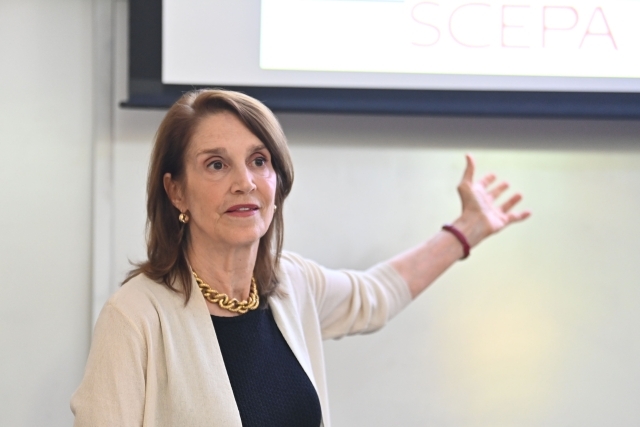
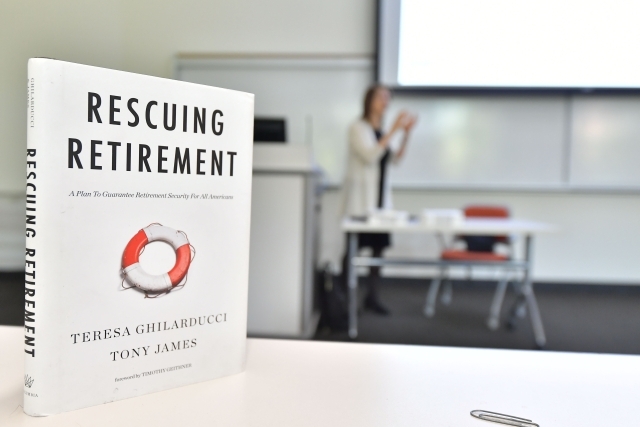
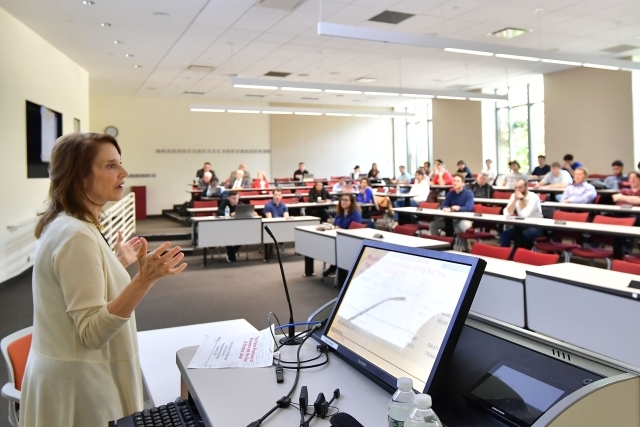
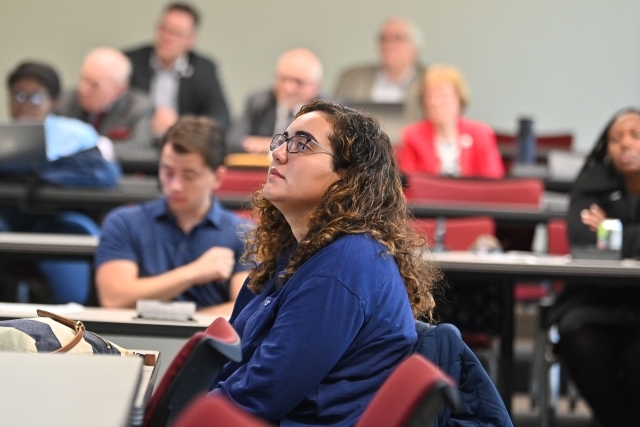
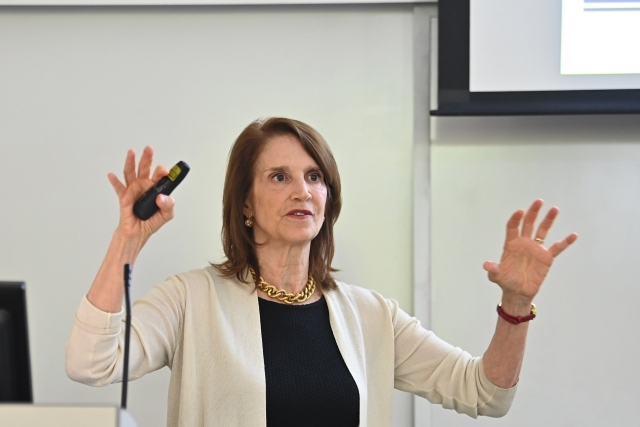
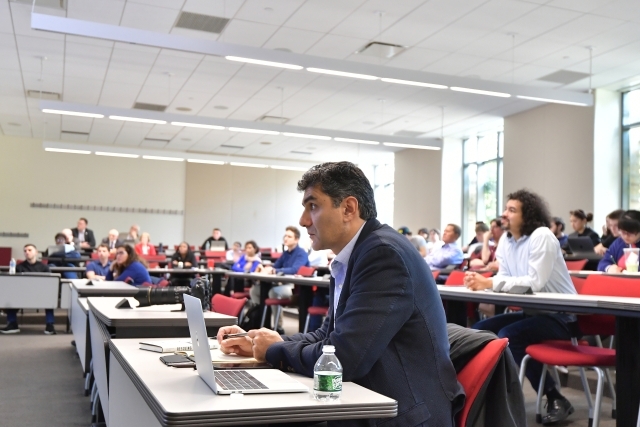
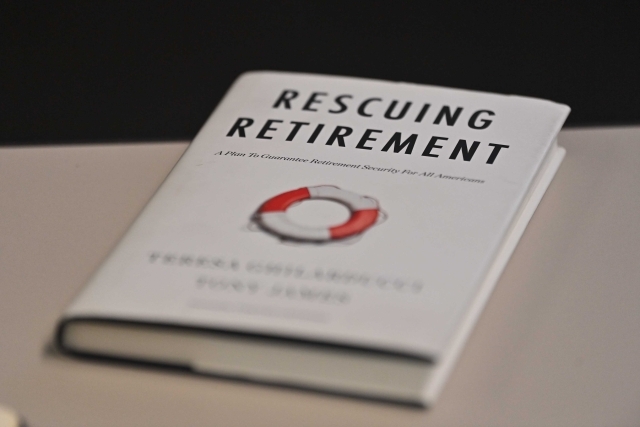







A nationally recognized labor economist addressed issues of retirement inequity and the need for effective postcareer planning at the Fall 2023 Henry George Lecture, presented by The Peter J. Tobin College of Business at St. John’s University on October 12.
Retirement expert Teresa Ghilarducci, Ph.D., told a gathering of St. John’s students, faculty, and staff that the current American retirement structure leads to “higher labor force participation among those in their 50s and 60s,” and that will “lead to, or exacerbate, the social divisions in our society.”
According to Dr. Ghilarducci, more than 28 million senior Americans could be forced back into the workforce because of a lack of retirement assets. That could stress domestic employment and send wages into retreat. It could also stress a health-care system that might not be equipped to deal with the physical limitations of older workers.
“There is the thought that in working longer you remain more engaged, you avoid loneliness, and your cognition improves,” Dr. Ghilarducci said. “But there is plenty of correlation between doing something you love in retirement and greater cognitive acuity and better health. Paid work over the age of 65 can kill you—and there is all sorts of evidence for that.”
Dr. Ghilarducci is the Irene and Bernard L. Schwartz Chair in economic policy analysis in the Economics Department at the New School for Social Research and directs the Schwartz Center for Economic Policy Analysis. She earned her Ph.D. from the University of California, Berkeley, in 1984. Her most recent book Rescuing Retirement: A Plan to Guarantee Retirement for All Americans, offers solutions to the emerging United States retirement crisis.
Since 1981, the Henry George Lecture series has welcomed thought leaders to St. John’s to explore relevant issues in economics. It pays tribute to Mr. George (1839–97), a 19th-century American political economist who advocated for progress, free trade, and social development.
The Henry George Chair is an endowed position at St. John’s created in 1981 with a grant from the Robert Schalkenbach Foundation. Aleksandr V. Gevorkyan, Ph.D., Associate Professor, Economics and Finance, has held the Henry George Chair since 2019.
According to Dr. Gevorkyan, Mr. George’s genius was to bring into debate some of the difficult topics of his era, many of which resonate decades later. That also made Dr. Ghilarducci a natural choice to address the St. John’s audience.
Dr. Gevorkyan said Dr. Ghilarducci’s work on retirement issues is of the utmost importance today given the “global pandemic, geopolitical pressures, concerns over job stability, and overall economic uncertainty.”
“It is a unique opportunity to learn from such a preeminent economist as Dr. Ghilarducci, and to learn and to ponder some of the urgent topics about inclusive and sustainable labor market policies,” Dr. Gevorkyan added. “These attempts to resolve the unfair socioeconomic outcomes are at the core of St. John’s purpose.”
Maciek Nowak, Ph.D., Dean, The Peter J. Tobin College of Business and the Joseph H. and Maria C. Schwartz Distinguished Chair, agreed.
“Dr. Ghilarducci’s work in labor economics, with an emphasis on job and retirement security, is of great importance for society today and is consistent with the university’s Vincentian mission to seek and develop effective solutions that can help overcome social injustice,” Dean Nowak said. “We are excited to honor Dr. Ghilarducci as our Henry George speaker this year.”
According to Dr. Ghilarducci, the primary retirement savings mechanism for most Americans is a 401(k) plan, 403(b) plan, or similar. These plans, initiated in 1978, have replaced the defined benefit, or pension, plans that were popular generations earlier.
The reduced availability of pension plans means that among the highest wage earners, 10 to 15 percent will have nothing but their own retirement savings and Social Security to live on. Forty-five percent of those in the middle class will be in a similar circumstance.
Given the limitations of Social Security, Dr. Ghilarducci said it is imperative to save for retirement, noting the value of compound interest in accumulating future wealth.
“It’s an absolute necessity,” Dr. Ghilarducci explained, adding that as workers near retirement age they need about 10 times their annual salary to avoid having to rejoin the workforce. “You must always think about how much money you need for retirement.”
Mr. George would have been keenly interested in the social issues created by retirement inequities, Dr. Ghilarducci said. As women assumed a more dominant role in the workplace, for example, their life expectancy began to fall closer to that of men. Dr. Ghilarducci also pointed to studies suggesting that, despite technology, the physical demands of work have not improved since the 1990s.
Today, the least-educated in America average about 12.6 years of retirement before death, she said. Those who live in retirement the longest are those with a defined benefit plan who can stop working earlier.
“You couple people working longer with people who are dying sooner and you have a big divide in retirement time,” Dr. Ghilarducci said. “There are also generational and inherited functions, such as access to health care, that are exacerbated by where you live and what you have.”
Dr. Ghilarducci said that while she opposes a mandatory retirement age, she supports “people at some point being able to decide whether to work or not.” She has supported a government-funded retirement account for Americans, similar to that of Sweden, and efforts to create an older workers’ bureau within the US Department of Labor.
Many workers in America retire sooner than they anticipated, Dr. Ghilarducci said, pointing to layoffs and corporate downsizing.
“If they have to go back to the workforce because they don’t have enough money, they take any job they can find,” she explained. “In Sweden, older workers stay in the labor force because the jobs are good.”
Related News
Alumna Celebrates Book Launch After Career Change
After developing a passion for helping the younger generation, Ashley Wilson ’14M.S.Ed. pivoted from a career in the music industry to work as an educator. She is also making her mark through her new...
Dean Jerrold Ross Conference Room Unveiled
On Tuesday, December 10, the newly renovated conference room on the fifth floor of Sullivan Hall was dedicated in honor of Jerrold Ross, Ph.D., former Dean of The School of Education . The renovation...
Institute for Catholic Schools Provides Educational Resources to Local Catholic School
The Institute for Catholic Schools (ICS) in The School of Education at St. John’s University recently donated approximately $2,800 worth of academic and sensory learning tools to Father Vincent...
